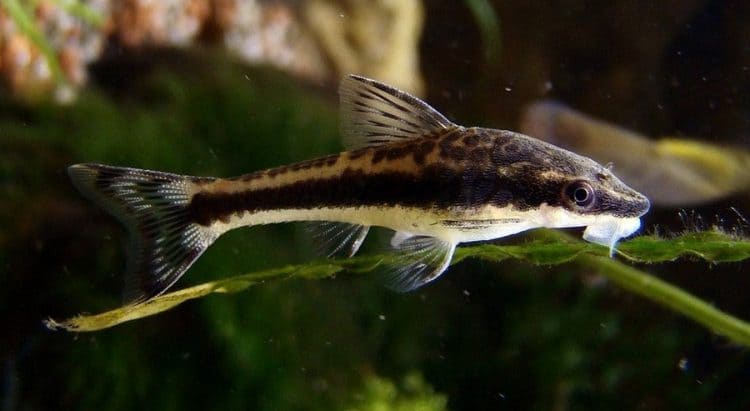
The Otocinclus genus are currently classified with the large family of Loricariidae, the sucker-mouthed catfishes. This genus is made up of very diminutive fishes, usually reaching no more two inches long at maturity. They are generally coloured in shades of creamy beige and browns, with occasional species exhibiting dark, almost black, markings. Those species that have markings can be either mottled, spotted or striped. Otocinclus (commonly referred to as otos) are basically oval in shape, with a quick tapering off to the small tail. Finnage is generally unremarkable, both in size and shape.
These fish are natives of South America and may be found in various regions, including Brazil, Paraguay, Peru and Bolivia. Their preferred habitat there is very clean, clear water which is highly oxygenated by quick currents and in heavily-vegetated areas of fast-flowing creeks, usually in fairly shallow areas – as little as two inches deep.(In an aquarium, these fish are very susceptible to nitrate damage, and should not be used to cycle a newly established aquarium). Otos are almost always found on the flat surfaces of plants, where they like to graze on their favorite foods, algae and the micro-organisms which live in the algae. In the aquarium it is not always possible to provide enough algae for them, but they may be fed supplementary foods such as sinking tablets or wafers, blanched vegetables (including zucchini, broccoli, peas or spinach) and the occasional feed of frozen brine shrimp (which has first been thawed).
Otocinclus are small, peaceful fishes, often doing better when kept in groups, although they are not truly a schooling fish. They make an excellent choice for an aquarium that is populated with other small, shy fishes. The otos are usually most active at night, therefore, feeding in an aquarium should be planned accordingly – after the lights go out. A tank should be densely planted for these fish, and should include a piece of bogwood. Bright light does not particularly bother them, so cultivating algae isnt difficult to accomplish. Should there not be enough algae for them in an aquarium, they may damage very delicate leaf growth, but this is very rare, since there are few plants NOT tough enough to withstand the assault of a tiny otocinclus.
This fish prefers water with a pH of 6.0 to 7.5, but the hardness may vary from 2 to 18 dGH. It is most important that there be no nitrites and very little nitrates. A well matured tank is crucial to their survival. The temperature can be set between 20 to 25 degrees C. A good current should be provided at the surface in order to insure good oxygenation. The aquarium should be at least two feet long, although many have been kept with great success in smaller tanks.
It is possible to breed these fish in aquariums. The eggs will be adhered to plants and the glass. The fry will hatch in two to three days (dependent on temperature), and will require very small foods at first, such as infusoria, algae, and newly hatched brine shrimp.
Otos are perfect for the smaller tanks, and even for the largest of tanks when kept in large groups. They are excellent community fish to keep, easy to feed when algae growth isnt plentiful, and they clean unsightly algae from plants without rasping the plants away to nothing. They just might be the perfect example of good things come in small packages.
Leave a Reply